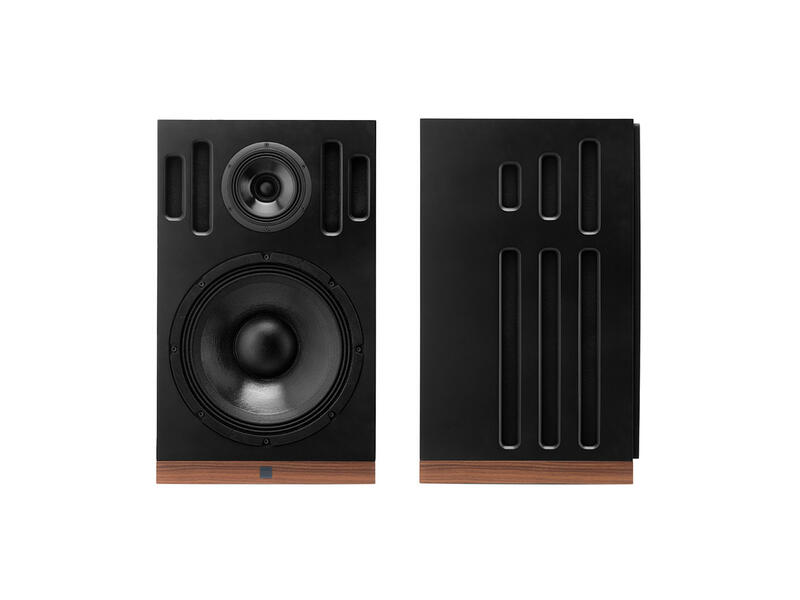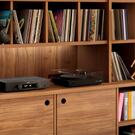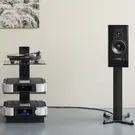The industry hasn’t quite been ready to adopt active speakers and, strictly speaking, this might also have been the case for the average hi-fi enthusiast too. It would seem that the lack of opportunity to upgrade, improve and tweak the system, in combination with leaving all sonic choices to the designers of active speakers, has put a dampener on any enthusiasm. This is understandable, but it also means that people are missing out on a golden opportunity to acquire better sound quality for their money than they can get with the other available solutions in this price range, and by a good margin too. on stands.jpg
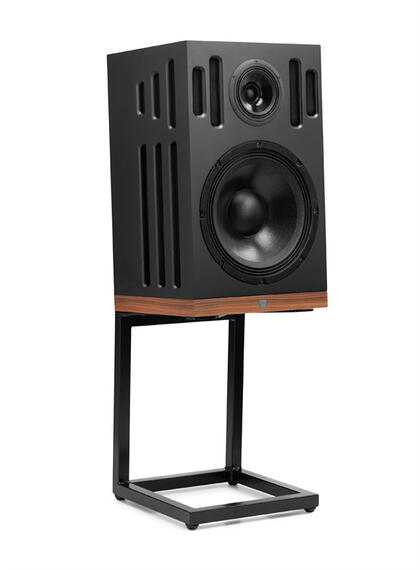
Active speakers
It may seem a little daunting to hand over control of the majority of the signal chain to the speaker designer, but all of the active systems we have listened to actually play better than any passive speaker set-up. Sigberg Audio has chosen a somewhat unusual component placement for the Manta. It boasts a huge12-inch mid-bass, which delivers a large and impressive mid-bass rendition with incredible purity. At the same time, it does not reproduce any more of the deepest bass, so you still need a couple of powerful subwoofers to get a complete full-range system with sound reproduction down to the 20Hz range. The mid-range and treble are reproduced by a coaxial element with a 1-inch treble with a silk membrane installed in the middle of the 5.5-inch mid-range speaker.
A triple-channel Hypex nCore amplifier with DSP is used to operate these elements. It delivers as much as 600 watts per speaker, which means you can play your music really loud. Sigberg Audio states that each of the speakers can play at 122dB. This results in impressive volume, but, more importantly, the speaker offers very solid dynamic reserves. This is the case across the entire working range of the speaker, but it might be most impressive in the mid-bass, where the large 12-inch reigns, playing entirely without any audible compression. It also demonstrates in the best possible way just how important complete control in the important bass range is when it comes to the overall rendition. A solid 12-inch simply takes you to a completely different world than a 6.5 or 8-inch mid-bass that has been pushed to its limits.
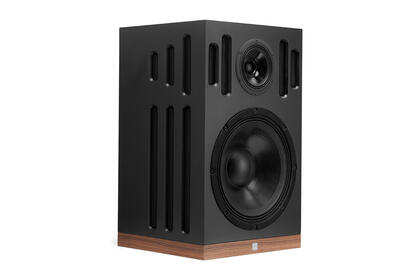
The elephant in the room is space
I have previously said that a lot has already been achieved as long as the focus, holography and three-dimensionality are in place. If bass rendition is also controlled, tightly and free from distortion, I can easily live with the fact that the rest of the rendition is not as impressive. To a certain level, obviously.
The active Manta speakers have been designed with a cardioid diffusion pattern This is not a new principle, you might have come across it in relation to microphones, for which it is described as a kidney characteristic. They differ from other microphones by absorbing less of the sound behind and to the sides of the microphone. But how is this transferable to a speaker?
The way in which Manta has been designed means that the speaker has less diffusion towards the back and sides, thereby directing more energy forwards. This is achieved through the acoustic slits or vents you can see at the front and sides of the speaker - in a carefully planned pattern. Less of the sound is therefore sent towards the reflective surfaces in your space and more is directed towards the listener and the “sweet spot”. Of course, you could achieve much the same effect by covering your living room in various acoustic aids, but we both know that this is largely an impossible task if you also want your living room to be habitable.
Manta’s controlled diffusion has a profound impact on how you perceive space and three-dimensionality, while the rendering becomes purer, more natural and more believable. This is something you will notice immediately with Manta. You will still get plenty in return for the time you spend positioning and angling, but the starting point is several levels better than virtually any other speaker.
Manta can be positioned very close to the wall and, even though I eventually ended up placing it around 40 cm out from the wall, it worked well much closer too, without the bass range becoming too bombastic. The only reason not to position it adjacent to the wall is the holography and focus of the speaker, which I felt came through even better when it was positioned a little way from the wall. However, there is no doubt that the Manta is very space-friendly.
But this may not be the case for the subwoofers. Even though they are easier to integrate than many other subwoofers we have tested, they still have the inherent characteristic which means that they shouldn’t necessarily be positioned in the place that would make sense from an interior design perspective. However, two is always better than one, but don’t think you’ll be able to tune them using just your ears. Get help from the supplier or a reseller or use a measuring microphone and appropriate software – as well as a generous dose of patience.
I use the AudioTools software (iOS) from Studio Six Digital. It has everything if you use the full version, but even the most affordable version of the software includes everything you need. It also has a number of calculators to help you work out room nodes, wavelengths and similar, as well as built-in signal generators.
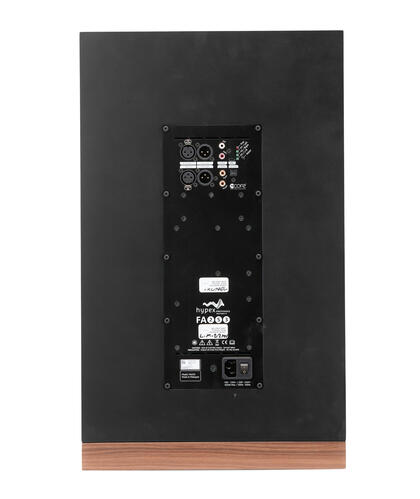
User-friendly, but…
If you want to take full advantage of the advanced features of the speaker, you need to connect a PC. This might be a bit challenging for beginners, but it’s hard to imagine these speakers being bought by audiophiles with no prior hi-fi or technical experience. Ideally, I might have preferred for some of the available user settings to be available on the back of the speaker, for example input selection, but there are limits to what there is room for.
Connected to a PC (Macs are not supported), the speaker can be configured according to personal preference, including source selection, automatic signal detection, adjustment of the balance in the treble range and a 9-band parametric EQ for advanced users.
You can choose between a number of analogue and digital inputs. You will also find an analogue RCA and an XLR-balanced input, as well as optical, coaxial and AES digital inputs. The signal delay is as short as 0.35 milliseconds when using analogue inputs and 1.8 milliseconds when using one of the digital inputs. These delays are completely negligible, regardless of context and usage.
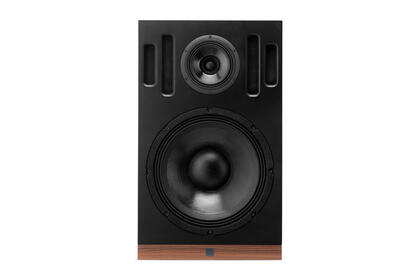
Very precisely balanced
Without connecting a single subwoofer, the Manta sounds rich, relaxed and very well balanced and it is absolutely possible to listen without any help in the bass range. It has a homogeneous and very well-balanced playback that was spot-on in my living room without having to adjust as much as a single dB up or down. Together with the clean and impressively transparent sound, the speaker created a calm, relaxed and very comfortable music experience. Many people might be surprised at how smoothly, naturally and effortlessly the music is rendered and how similar the instruments sound to what you might experience at a concert. It might be easy to imagine electric instruments in full flow on a stage with a complete PA setup, but acoustic instruments also come across well. Just listen to the recording of Ole Bull’s Violin Concertos by Annar Follesø and Kork, especially the track I Ensomme Stunde (2L). It is experienced with sparkling intensity and a beautiful violin that takes centre stage against the backdrop of the orchestra. The speaker disappears from the soundscape completely, leaving me with a beautifully positioned orchestra, making it very easy to identify individual instruments and groups and with a violin sound that has been taken straight from the soloist’s position on a concert stage. The experience is intimate and insightful and extremely emotional. If you have ever sat alone in the mountains at dusk and looked across a still mountain lake, this would be the musical equivalent. It is quiet, relaxed and far removed from the noise and racket that surrounds us on a daily basis.
I decided to immerse myself, or perhaps even become completely overwhelmed by Phoebe Bridgers’ beautiful, naked voice on Georgia. The song is presented with a voice that is completely naked, but also so inviting, warm and delicate that I experience another bout of goosebumps. The recording offers a voice that many experience as too grey and bland when the balance and precision are inadequate. Here, the sound is rich and juicy in the bass and the bass drum and it sounds refined, tender and colourful throughout the entire vocal range.31.01.230083.jpg
At the same time, Manta performs very well when a recording requires much more powerful and focused energy and sparks fly when required by the music and recordings, showcasing an impressive dynamic. This becomes even more clear when I go a little harder and fire up Tool’s Invincible. I eventually found myself turning the sound up surprisingly loud, which only happens when the sound doesn’t appear pressured, compressed or strained when the volume is raised significantly above normal listening levels. Fortunately, you can also play it fairly quiet and gently without the speaker losing any of the fullness from the bass and mid-bass. You can feel the mid-bass reproduction, as we have also experienced before with some other speakers with large basses and slightly “old-fashioned” cabinet proportions.
You could perhaps turn the speaker up even more, but there would be a risk of losing control, as well as losing the addictive tidiness and the incredible grip on the three-dimensionality of the sound rendering.
Fantastic feeling of space
There is a lot that can be said about tonal balance, tightness in the mid-bass range and the openness in the mid-range and treble speakers, but what I am really left with after the test is an almost shockingly precise and three-dimensional soundscape. It’s almost like sitting in a studio with excellent acoustics, listening to a couple of studio monitors or even better, being present where the sound originates. With an ensemble, band or orchestra at an appropriate distance from you.
The depth of the soundscape is impressive, the space between the instruments unusually generous and the sound extends well to the sides without losing energy. For me, this is a very attractive quality and I appreciate the opportunity to not only listen to music, but also to “take a good look around me” in the lush, rich and highly focused soundscape. You can start at the outside and peel off layer upon layer of timbre and sound until the music fades out and disappears to the very back of the soundscape.
With music that has been recorded in very large and airy spaces in the player, I can only conclude that this is impressive in every way. When playing Nidaros Cathedral Girls’ Choir, Trygve Seim and Ståle Storløkken and the 2L release Lux, the system takes me out of reality and moves me around 500 kilometres north, before dropping me straight into the enormous sound that can be found in Nidaros Cathedral. It was a powerful and lasting experience and undoubtedly something that would enrich life for anyone who loves music.
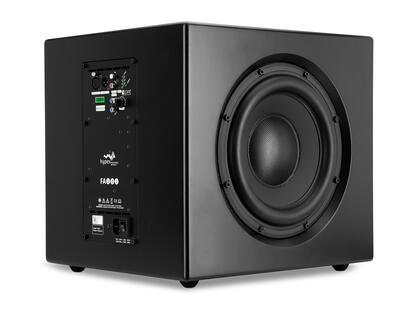
The whole – and a couple of subwoofers
I’m never quite certain that I’ve managed to find the perfect spot for subwoofers, but when the ears are happy and the measured sound curve looks more than usable, there is reason to believe that things are OK. The desire to tweak and adjust things a little with each song that is played back has also gone, which is also a good sign that the balance is pretty much as it should be.
Two Sigberg Audio subwoofers and a Manta set have a bundle price of NOK 250,000, but it’s worth noting that you also need a good source – with volume control.
The sound quality is not objectively improved by a couple of subwoofers, but it is somewhat unusual to find that it also does not deteriorate. The addition of the bass allows the sound to move effortlessly down to around 20Hz and, when it is well balanced, as it is here, it sounds exactly the same as when you play it back on the Manta only. The difference is that you add two whole octaves at the bottom, giving the sound even more weight while also having the effect of making the space appear even bigger and more convincing. The tracks described above become juicier and richer and who could imagine that Nidaros Cathedral could grow into something that feels twice as large with just the addition of a couple of subwoofers? The bass also packs more of a punch on the demo tracks I use from Trentemøller and Infected Mushroom, which undoubtedly makes those who enjoy a bit of bass cheerfully stomp their feet along to the beat. The subwoofers are tight and controlled as expected, but it’s the relaxed excess and lack of distortion and noise that produce the big, clean and clear overall music experience. Of course, this means that the very sensibly designed subwoofers also disappear completely in the soundscape.
Conclusion
The sound quality of Sigberg Audio’s Manta and the accompanying 10D subwoofers is an impressive experience in every way and you would need to invest quite heavily in passive speakers and electronics in order to compete – and that’s without taking the amazing holography and focus of the speakers, as well as the highly impressive feeling of being in the recording studio or close to the stage, into account.

 Vipps oss en gave: 129702
Vipps oss en gave: 129702